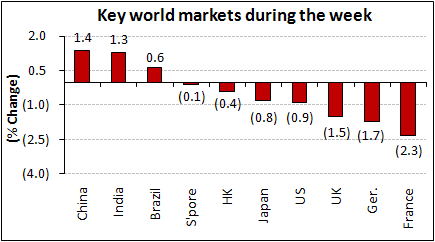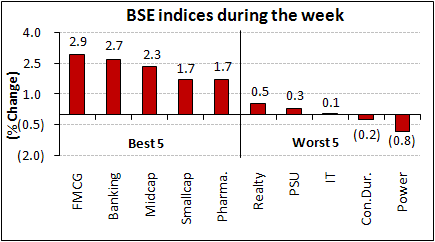India's Third Giant Leap
This Could be One of the Biggest Opportunities for Investors
- Home
- Todays Market
- Indian Stock Market News August 21, 2010
Emerging markets the sole gainers Sat, 21 Aug RoundUp
The past week was a mixed one for global stock markets as emerging markets ended the week with gains, while those in the US and Europe ended the week on a sour note. One of the key factors was of the US Labor Department reporting that the initial jobless claims rose by 12,000 to 500,000 in the week ended August 14. This was above the forecast of 478,000. In addition, concerns over the drop in commodity prices added to the woes.
Leading the pack of losers was France which ended lower by 2%. Germany, UK and US followed suit with losses of 1.7%, 1.5% and 0.9% respectively. China, India and Brazil ended the week on a positive note. While China and India ended higher by over 1%, Brazil ended the week with a gain of 0.6%.
 |
| Source: Yahoo Finance |
Moving on to the performance of sectoral indices in India - stocks from the FMCG and banking spaces were amongst the preferred lot this week as the BSE-FMCG and BSE-Bankex ended the week with gains of about 3% each. The BSE-Healthcare Index followed suit with a weekly gain of 1.7%. Amongst the top underperformers were stocks from the power and consumer durables spaces as the BSE-Power and BSE-Consumer Durables indices ended lower by 0.8% and 0.2% respectively. IT and realty stocks ended with marginal weekly gains.
This week, mid and smallcaps were in favour as the BSE-Midcap and BSE-Smallcap indices ended the week higher by about 2% each as compared the India's benchmark index, BSE-Sensex's gain of 1.3%.
 |
| Source: BSE |
Moving on to key corporate developments during the week, a few companies announced their results for the quarter ended June 2010 this week. We have highlighted some of the key ones below.
FMCG major, P&G Hygiene announced its full year results (year ending June). The company reported a revenues growth of 17% YoY for the year. Growth during FY10 was led by a strong double digit growth in its feminine hygiene segment. In value terms the feminine hygiene segment grew by 22% YoY. The company's revenues were also supported by its healthcare business which grew by 11% YoY. At the operating level, the company reported a profit growth of 10% YoY. The increase in operating profits was lesser than the increase in revenues on account of a 19% YoY increase in expenses. Operating margins contracted by 1.6% to 25.4% on the back of higher raw material costs. An increase in advertisement costs also impacted the company during the year. P&G's profits remained flat for the year. This was a result of fall in other income and higher depreciation charges.
Gujarat Industrial Power Co. (GIPCL) also announced its numbers for the quarter ended June 2010. The company's topline declined by 4% YoY on the back of a similar decline in power generation. This was caused by lower capacity utilization at two of its three plants - Vadodara Station II, and Surat Lignite Power Plant (SLPP). GIPCL's operating profits however rose by 3% YoY as operating margins improved by 0.9% YoY. This margin expansion was brought about by lower fuel costs. These costs declined to 64.3% of sales in 1QFY11, from 66.8% in 1QFY10. Led by higher operating margins, as well as a one-time tax credit, GIPCL's net profit grew by a strong 42% YoY during 1QFY11. The interest costs also came down by 26% YoY. Excluding the one-off tax credit of Rs 88 m during the quarter, the net profit growth stands at just around 12% YoY.
The stock of wind energy major Suzlon Energy dropped by a massive 13% this week. This decline in its stock price was on account of various factors led by its poor results. The company reported a 42% YoY decline in sales and a loss of Rs 9 bn during the quarter. This poor performance was mainly due to a fall in sales volumes of wind turbines. Plus, the gear box sales are also not fully comparable as the company sold a stake in its gear box subsidiary (Hansen Transmissions) during FY10. As such, these sales have not been consolidated this quarter. In fact, the company reported a loss of over Rs 5.5 bn at the operating level itself. Also a relatively lower fall in interest costs and depreciation charges compared to the fall in turnover impacted performance.
Apart from its poor results, the pressure on the stock was added on the back of the world's largest wind energy turbine manufacturer, Vestas Wind Systems, cutting its guidance substantially. Vestas announced its latest quarter results recently, wherein it reported a massive loss of 110 m Euros as against a 43 m Euros profit last year. Similar to the problems that Suzlon is facing, Vestas witnessed issues such as delay of orders caused by the current credit crunch. In addition to delivery delays, tight financing and regulatory uncertainty are played their part. Considering that Suzlon is amongst the top wind turbine manufacturers in the world, one cannot ignore Vestas' outlook. However, recently, Suzlon's management had stated that they are seeing the scenario picking up in emerging markets, while those in the US and Europe remain sluggish.
During the week, a leading news daily reported that auto major Tata Motors plans to raise US$ 700 to 750 m through the issue of shares with differential voting rights (DVRs). This development is part of the company's plan to raise US$ 1 bn (Rs 47 bn) in order to retire debt. The DVR shares will be issued on the same terms and conditions of the existing DVRs. Globally DVR shares trade at a 10 to 15% discount to ordinary shares as they have limited voting rights. They are issued when the company wants to raise money but does not want to cede voting rights. Tata Motors DVR shares were listed in November 2008 and have 1/10th of voting rights of ordinary shares. However, such shareholders receive 5% higher dividend. It is reported that institutional investors are of the view that Tata Motors should opt for a sponsored issue for its DVRs. In a sponsored issue, the company does not issue fresh shares. Instead, it facilitates the sale of shares from existing ones to the new shareholders in the overseas markets. This reduces the supply of fresh shares and can boost prices in times of demand thereby bridging the gap between the discount in prices prevailing between DVR and ordinary shares.
Moving on from one auto major to another, Maruti Suzuki recently announced that it has crossed the milestone producing over 0.5 m units of its latest generation K-series engines. This it has been able to do within a period of two years. Manufacturing of these engines was initiated in October 2008 and is now available in seven models. These include the Alto-K10, Wagon-R, Swift, Ritz, Estilo, Swift Dzire and A-Star. The company also stated that it has been able to scale up the production of these K-series engines manifold. At present, the company is able to produce 0.5 m engines annually. It has recently announced to scale this up to 0.7 m by 2012.
| Company | 13-Aug-10 | 20-Aug-10 | Change | 52-wk High/Low | |
| Top gainers during the week (BSE-A Group) | |||||
| Jet Airways | 660 | 815 | 23.5% | 831 / 239 | |
| Bhushan Steel | 1,608 | 1,837 | 14.2% | 1,856 / 950 | |
| UCO Bank | 102 | 114 | 11.7% | 117 / 42 | |
| Grasim | 1,883 | 2,091 | 11.1% | 2,332 / 1,683 | |
| Ranbaxy | 445 | 493 | 10.7% | 538 / 300 | |
| Top losers during the week (BSE-A Group) | |||||
| Suzlon | 57 | 49 | -13.3% | 105 / 49 | |
| HCC | 71 | 64 | -9.0% | 81 / 52 | |
| Nalco | 436 | 401 | -8.0% | 526 / 328 | |
| Sesa Goa | 352 | 328 | -6.8% | 494 / 211 | |
| Jubilant Organosys | 355 | 332 | -6.6% | 413 / 219 | |
The latest economic data released this week showed that the headline inflation number - the wholesale price index (WPI) rose an annual 9.97%. This is below the median forecast for a 10.4% rise and compared with June's rise of 10.6%. India's headline inflation, the highest amongst the G20 major economies, continues to remain the single largest concern for the government. In response to the high inflation, the RBI has raised it's the repo rate by 1% so far this fiscal and is widely expected to continue its calibrated tightening. Although the WPI for July has come in a tad lower, the same is expected to go back to double digits for the month of August once the impact of fuel price hikes get fully factored in. The government expects the WPI to come down to 6.5% by the end of this fiscal.
As per the figures published by the World Steel Association, global steel production has risen by 25% YoY in the year till date (January to July 2010) to over 820 m tonnes. However, the July 2010 steel production is lower by about 3% on a month on month basis i.e. as compared to June 2010. The interesting part is that while steel production in Asia has risen by 5.7% during July (as compared to July 2009), steel production in EU and US rose by 23% and 33% respectively. This is despite, the global steel (of 66 countries surveyed) production utilisation levels declining from 80.4% in June to 75.1% in July. On a year on year basis, utilisation level is up by 2.7%. China, the world's largest steel producer reported an 18.2% YoY rise in the January-July period as compared to the corresponding period last year. However, for the month of July 2010, the country's steel production is higher by only 2% YoY. In India, crude steel production was higher by 5.7% on a year on basis (during the month of July 2010).
These are encouraging signs and reaffirm the positive and steady recovery of developed markets. Also the fact that China's share in the recovery of steel production has relatively declined as compared to a few quarters ago adds to the confidence.
For information on how to pick stocks that have the potential to deliver big returns, download our special report now!
Read the latest Market Commentary


Equitymaster requests your view! Post a comment on "Emerging markets the sole gainers". Click here!
Comments are moderated by Equitymaster, in accordance with the Terms of Use, and may not appear
on this article until they have been reviewed and deemed appropriate for posting.
In the meantime, you may want to share this article with your friends!